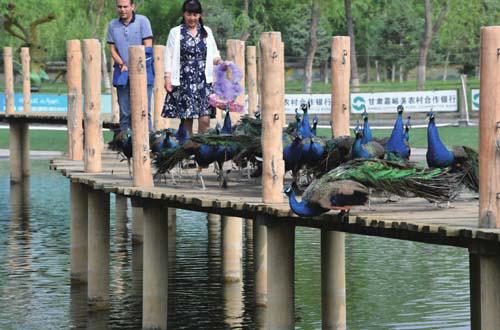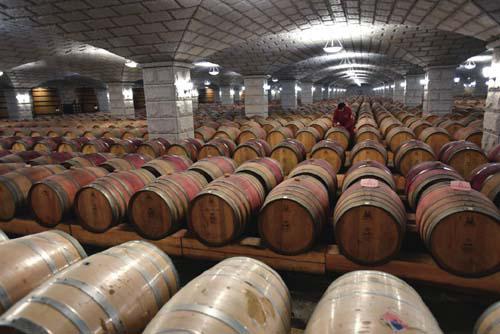The Art of Reinventing
By Wang Hairong



To the sound of a whistle, a row of peacocks march onto a narrow bridge behind a woman carrying a basket of food for them. As she walks, the woman sprinkles a bit of food from time to time while the peacocks peck and trail behind her, cackling loudly. The woman happens to be a staff member at the China Peacock Court, a large peacock farm in Jiayuguan, a city in northwest Chinas Gansu Province.
Suddenly, the woman issues an order, and the peacocks take off one by one, fl apping their wings strenuously to fl y across the lake and land on the rails on the bank. “It is rare to see peacocks fl y, but we have managed to train them to perform for visitors,”Yang Hui, General Manager of the peacock farm, told Beijing Review.
Launched in 2012, the farm is now home to approximately 30,000 peacocks and peahens—most of which are blue, with a small number green and white—and embodies Jiayuguans effort to adjust its economic structure and enrich its tourism resources. Occupying an area of 60 hectares, the farm is the largest breeding and feeding ground for blue peacocks in Asia, Yang said.
An iron and steel city
Although named after the Jiayuguan Pass, the westernmost end of the Great Wall built in the Ming Dynasty (1368-1644), Jiayuguan City really credits its birth to the Jiuquan Iron and Steel Group, also known as Jiugang.
In 1955, geologists discovered a large iron ore deposit in the vicinity of the Jiayuguan Pass, leading to the founding of Jiugang three years later. As more and more people from other parts of the country flocked to work for the plant, the area was offi cially established as a city in 1965.
In the ensuing decades, Jiugang grew into the largest iron and steel production base in northwest China. “If Jiugang sneezes, the city will catch cold,” Li Ning, an official with the citys Development and Reform Commission, once told the media.
Jiayuguan was characterized by a small primary industry, a large secondary industry and a weak tertiary industry. Located in the heart of the Gobi Desert, the citys agriculture is negligible. The manufacturing of iron and steel once contributed to 80 percent of the citys GDP, Li said.
But the iron and steel city faces two grave development bottlenecks. In recent years, China has suffered from an overcapacity of iron and steel production. As a result, in December 2015, the Central Economic Work Conference decided to promote supply-side structure reform and make cutting overcapacity, especially in steel and coal industries, a top priority.
In response to the Central Governments decision, Jiugang has cut its iron and steel production capacity by approximately 5 million tons since 2015, said Yang Hongwei, a former employee of Jiugang and currently an executive at Zixuan Wine, an outgrowth of Jiugang. Yang said that Jiugang shut down two plants, one in north Chinas Shanxi Province and the other in Lanzhou, the capital of Gansu.
In addition to a glut in production, Jiugang faces a more fatal threat, Yang said. It has been estimated that the iron ore deposits that Jiugang lives on will be depleted in three decades, which compels the company and the city to explore alternative income resources, he added.
In recent years, Jiayuguans Municipal Government has decided to adjust the citys economic structure by fostering emerging industries such as photovoltaic power generation and new construction material production as well as food industries such as wine making, diary production and animal husbandry. It also vigorously encourages the development of the tertiary industry. Promoting the integrated development of cultural and tourism sectors has been the citys most important measure to boost its tertiary industry.
The measure has yielded results as data from the municipal government shows that the proportion of the primary, second-ary and tertiary industries shifted from 1.4:71.6:27 in 2013 to 2.2:51.8:46 in 2017. The city, with a population of 300,000, received about 8.57 million visitors last year, registering a year-on-year growth rate of 22 percent, according to data provided by the local government.
Diversified tourism resources
Jiayuguan is rich in cultural tourism resources, the most famous of which is the Jiayuguan Pass. Built in the 14th century, it used to be a defense fortress and a bustling transportation hub along the Silk Road. Now, like an aged hero, it still stands proudly and commandingly, attracting tourists to come and admire it.
Other well-known heritage sites in the city include the Wei-Jin Tombs, the Overhanging Great Wall and the First Beacon Tower of the Great Wall.
About 1,400 brick tombs built during Wei and Jin dynasties (220-420) are scattered underneath a large stretch of the Gobi Desert, with exquisitely painted bricks embedded in the tomb walls. The murals depict a variety of daily activities such as farming, hunting, dancing, sericulture, eating and drinking. They not only yield aesthetic value, but also attest to the relatively humid weather and the social customs of the time. An image from the paintings of a mailman on horseback was adopted as a stamp in 1982, becoming a symbol of Chinas postal system.
Another of the citys famous heritage sites, the Overhanging Great Wall, is part of the ancient Jiayuguan defense system. It is perched on the eastern side of the Black Mountain, which lies about 7 km northwest of the Jiayuguan Pass. Viewed from a distance, this section of the Great Wall appears to be a dragon crouching over the steep slope. Statues built at the foot of the mountain depict famous historical fi gures. The wall was built of layers of a blend of gravel, yellow earth and straw, while the bricks were made by setting the mixture in the sun to dry. The adobe bricks were tested by shooting arrows into them and only the bricks that could resist being pierced by the arrows were used to build the wall.
Rich as Jiayuguans cultural heritage is, the city wants to do more to lure tourists to stay for longer visits. Against this backdrop, the China Peacock Court has emerged as both a breeding farm and a tourist attraction.“Last year, 320,000 tourists visited the peacock farm, bringing in more than 8 million yuan ($1.22 million) in profits,” said Yang. The farm has generated jobs for over 100 people.
With lush meadows, lakes, artificial hills and wooden sheds, the farm is like a big park. Peacocks loiter on the grounds, displaying their magnificent tails occasionally and shrieking constantly. The park even boasts tropical plants such as palm and banana trees, making a bunch of bananas hanging from one tree a rare sight in the northern desert area.
In addition to peacock viewing, the park also offers wedding services, hosts performances and features a recreational area for children.
Raising a tropical bird in Gansu, which has a drier and colder climate, is a challenge.“None of the first batch of peacocks we raised in 2012 survived, either because of their maladjustment to the climate or the food,” Yang said.
The farm invited experts from several universities to tackle the problem. Now peacocks live in specially designed rooms in winter, and they are fed food containing over 10 ingredients such as carrots, wheat, corn and beans.
“Now the eighth batch of peacocks has been bred on the farm,” Yang Jia, a staff member, said, adding that peacocks usually have a life span of 20 to 25 years, with their prime lasting from three to fi ve years.
Similar to the China Peacock Court, Zixuan Wine is also a combination of production facility and tourist attraction. Founded in 2005 by Jiugang, the winery is now one of the two largest of its kind in Gansu.
In its spacious and stylish wine cellar, Yang Xingyuan, who is in charge of cultural and tourism affairs for the company, introduced it to visitors.
He said that Jiayuguan, with its dry weather and plenty of sunshine, has an environment favorable for planting grapes. To develop the wine-making industry, Jiugang dispatched more than 300 employees to work there and invited experts from Northwest A&F; University based in Yangling to oversee the production process. A vineyard of more than 3,000 hectares was cultivated to supply raw materials for production.
“The winery was set up to meet high standards. We use the worlds leading technology. Our liquid filing line was imported from Italy, and wine barrels were brought from France and are among the best in France,” Yang Xingyuan said.
He lauded Jiugangs decision to set up the winery as visionary and of lasting importance, since it is a precaution against iron ore depletion in the future.
Currently, the winery has an annual production capacity of 50,000 tons. It has developed more than 80 product varieties in four series, namely, dry wine, ice wine, liqueur and brandy, he said. The products have been distributed to more than 20 provincial level administrative areas across China.
The winery also receives an annual average of 70,000 tourists who bring in a yearly income of more than 5 million yuan($765,500). Tourists can tour the winery and participate in a wine-tasting activity at a long table set with flowers and sparkling wine glasses with bottles of various sizes.
In addition to production facilities open to tourists, a large-scale amusement park was built in Jiayuguan to offer tourists a modern thrill apart from climbing the Great Wall and visiting ancient tombs. Fantawild Adventure, built by a Shenzhen-based company in south Chinas Guangdong Province, features art performances and themed adventures, such as the exploration of the Silk Road, China Space City and the Tanggula Snow Mountains, as well as an exhilarating ride along a torrent.
Green city
In addition, on a street in Jiayuguan stands a landmark statue that is conspicuously out of place considering the citys desert location. It is a statue of a giant dolphin, but after visiting the East Lake Park nearby, one understands why the marine animal has been chosen. The East Lake, surrounded by dense forest, covers 560,000 square meters that reminds one of the sea. Standing at a sightseeing platform at the top of a high-rise building at the center of the park, Wang Lihong, Deputy Director of the Jiayuguan Bureau of Parks and Forests, said that the surrounding area, including the lake, forest and modern residential neighborhood, was once desert lands.

Since a forestation campaign was launched about two decades ago, the green coverage ratio in this oasis city has increased from 4 percent in 1994 to the current 39 percent, Wang said. She recalled that when she started working in Jiayuguan in the early 1990s, she often rode a bicycle to the fields to plant trees, bringing her lunch along.
Local people support forestation not only by participating in tree planting, but also by regularly paying a greening fee to fund the forestation effort, she said.
According to data from the municipal government, the city currently has more than 110 public green spaces and 13 parks, all open to the public free of charge. It even has a large wetland park, the Caohu National Wetland Park, which sprawls right next to sand dunes.
At the inception of the city, trees were planted simply to shield against wind and sand, so only one or two varieties of trees were introduced. Later, the city cultivated 62 plant varieties that suit local conditions on the basis of the careful study of local climate, soil and plant characteristics. These varieties share some common features, such as resistance to wind, drought and cold, and are all inexpensive.
As a result of all these projects, Jiayuguan, with its rich cultural resources, lush vegetation and plenty of bodies of water, has transformed into a comfortable place for locals to live and for tourists to visit.

